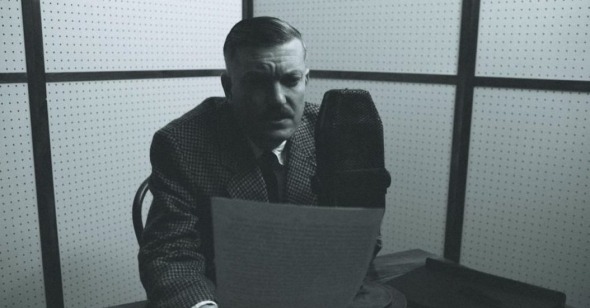Eternal Return
By Julia Gunnison
What Are the Wild Waves Saying?
Dir. Declan Clarke, 2023, Germany
Screening Sunday, May 7 at Anthology Film Archives as part of the 2023 Prismatic Ground festival
One of the more defamatory things you can call a documentary is a “history lesson.” Its seemingly pejorative edge comes from justified expectations that many viewers have for nonfiction films. Films cannot merely be vehicles for information, so this logic goes. To report on the past is a task better left to scholars, whereas filmmakers have a creative duty to deliver something more. They must interpret, demonstrate, dramatize, abstract, remix, lampoon, or otherwise treat history—not tell it. While this position places due emphasis on documentary as art, it also might underestimate what it means to tell. Declan Clarke’s What Are the Wild Waves Saying? (2022) is a case study for considering the relationships between documentary, history, and audience. The film tracks Irish writer Francis Stuart’s wartime radio broadcasting career in Nazi-era Berlin, and splinters off to other 20th-century linkages between Ireland and Germany. Employing text, voice, and photography in literal, informational modes, What Are the Wild Waves Saying? shows how the most complex questions and quandaries often lie directly on the surface of history. A “history lesson” is a rather apt description for the film and is perhaps not such a villainous thing for a film to be.
In 1942, Stuart began writing and delivering weekly broadcasts for Irland-Redaktion, a radio station dedicated to delivering pro-German propaganda to the public of neutral Ireland. Clarke is careful not to replicate the sins of his propagandist subjects and adopts measured formal strategies devoid of sensationalism. He relays his research through text on-screen and the occasional voiceover, while his images patiently supplement or elaborate on the evidence provided. With slow cuts that emphasize each individual shot as opposed to montage, he largely avoids building up sonic and visual layers, as if wary of misusing cinema’s persuasive powers. The narratives are rooted in individual biographies. This is far from the only or obvious approach to the material, yet it ensures the film’s fealty to specific actions rather than generalizations.
For Clarke, a stripped-down telling is the most effective method for opening up ideas about national ideologies: how they react to one another, fracture, and hold individuals captive. Though the film is spare and direct, the history it deals in is steeped in symbolism. At one point, the film recounts an episode when East Germany offered to repatriate Irish republican Frank Ryan’s remains to entice Ireland to officially recognize the East German state. They named this strategy “corpse diplomacy,” a term whose suitability as a metaphor is impossible to ignore. Ghosts and relics play an essential role in feeding nationalisms, their emotional power guiding how Ireland developed its relationship to Europe post-independence.
What Are the Wild Waves Saying? pays close attention to Berlin’s built environment. Unlike the windswept countryside that dominates Clarke’s depiction of Ireland—a choice that speaks to the immeasurable importance of land to the practical and emotional strands of Ireland’s nationalist struggle—buildings, streets, and radio towers attract Clarke’s camera in Germany. German reckonings with the past consistently return to urban space, and Berlin’s city landscape is a rich text for learning how Germany adjudicates historical memory. Clarke dedicates four minutes to silent observation of Stolpersteine: small plaques that memorialize individual victims of the Holocaust at the location where they lived. The Stolpersteine that appear in the film are clustered near Stuart’s former Berlin residence, but over 90,000 of these plaques are scattered across Europe. Initially conceived by artist Gunter Demnig, they have become a collective, in-progress “social sculpture”: anyone can submit a proposal to install a plaque. Translating to “stumbling blocks,” the Stolpersteine are effective public artworks, provoking confrontations with the past for anyone who passes through and notices. At its best, What Are the Wild Waves Saying? functions as a kind of stumbling block; a brief intervention that directs our attention to uncomfortable and perplexing corners of history.
What Are the Wild Waves Saying? was originally presented in the context of an exhibition. Clarke’s show “The Last Broadcast” collected artifacts related to broadcasting, propaganda, and intelligence mechanisms in Ireland and Germany. Though the film has also played at film festivals, a gallery might be a more suitable environment for experiencing the piece. A passage on East German intelligence activities of the Cold War almost mimics the concept of an exhibit, focusing as it does on documents, phones, radios, and other objects, displaying each in turn for the audience’s examination. This formal kinship likely works in the film’s favor, and better establishes conditions for how to read and engage with the work. But regardless of how seamlessly multidisciplinary works conform to a more traditional film screening format, the practice of coaxing moving image pieces across the boundary that divides visual arts and cinema is one of the Prismatic Ground festival’s best attributes. The prescribed pathways for how artworks reach the public are often arbitrary and inflexible. By resisting these norms, festivals can retain an ethic of discovery and avoid perpetuating a staid, closed circuit.
